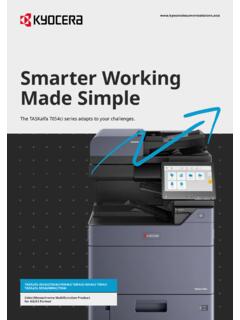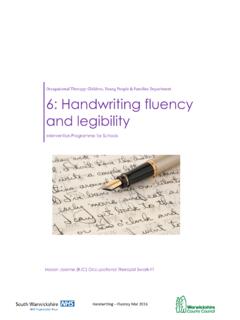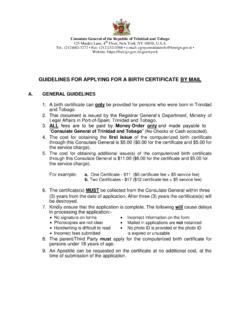Transcription of Evaluation Test of Children’s Handwriting (ETCH)
1 Evaluation Test of children 's Handwriting (ETCH). Purpose: The ETCH is criterion-referenced test to measure a child's legibility and speed for ages years old. There is a manuscript version (ETCH-M) for 1st to 3rd grade and a cursive version (ETCH-C) for 3rd to 6th grade. It is recommend that the child be familiar with the manuscript or cursive at least 10-12 weeks prior to the administering the test (Feder & Majnemer, 2003). The ETCH is designed to stimulate writing tasks required in school, and to assist with intervention planning, developing IEP goals and objectives, and to provide baseline data for progress monitoring. Time to administer: The test typically takes 15-30 minutes to administer, and 10-20 minutes to score. Scoring may take longer, especially the first few times administered. Format: The test kit includes: the manual, wall charts for far-point copying, task sheets for near-point copying, score sheets (reproducible), response booklets (reproducible), scoring standards for legible/illegible letters and words, scoring card ( peephole ), and quick reference sheets (instructions to administer).
2 Pencils and a stopwatch are also needed. There are 6 manuscript writing tasks and 7 cursive writing tasks to assess legibility (including letter formation, spacing, sizing, and alignment), as well as Handwriting speed . There are different directions and scoring for ETCH-M & ETCH-C: I. Writing Alphabet from Memory (both V. Manuscript-to-Cursive Transition (only upper case and lower case) for ETCH-C). II. Writing Numerals from Memory VI. Dictation III. Near-Point Copying VII. Sentence Composition IV. Far-Point Copying The following observations are also noted: Pencil Management includes pencil grasp, grasp descriptors (web space, thumb placement, finger positions), hand preference, writing movement, position of pencil & paper, pencil pressure, and manipulating pencil in hand. Classroom Observations includes: the child's seated position, behaviors during writing assignment, social interactions, classroom directions and routines, and writing ergonomics.
3 It is recommend to test in a well-lit, quiet room or corner of classroom, with proper desk and chair height for the child. The examiner sits next to child on side opposite of preferred writing hand or across from child. The examiner read the directions from the Quick Reference Sheet. If the child does not know the next letter/numeral from memory, after 15 seconds may provide 2 verbal prompts (report verbal prompts were provided). Be sure that no visual letters/numbers are available as a model ( letter chart on wall). Compiled by: C. Haynes, J. Kornbluth & L. Okonsky; Sept 2016; for EBS Healthcare, Inc. Evaluation Test of children 's Handwriting (ETCH). Scoring: Scoring practice is needed for competency. In the manual, chapter 5, there is a tutorial and competency quizzes (manual p. 81-137). Scoring of assessment can occur during and after administration.
4 When scoring start with last letter/numeral/word and work backwards. Scoring symbols on response sheets & scoring sheets (manual p. 16): ETCH-Manuscript Scoring Criteria (manual p. 59-67). ETCH-Cursive Scoring Criteria (manual p. 71-80). For IAB & II - place checks in boxes corresponding to symbols made on writing sample, then add number of O , U, and illegible letters. Subtract illegible letters from 26 for total of legible letters. Lastly, refer to chart for percentage of legible letters/numerals (manual p. 152 & 154). For remaining tests , tally up legible words/letters/numerals, fill in appropriate boxes Use chart to convert the time from seconds to minutes (manual p. 150). For III and IV determine letter/min by dividing the total letters in the task by the time in minutes (use calculator). For III-VI refer to charts for percentages (manual p.)
5 153 & 155-156). Total ETCH Legible Scores - transfer "total legible" words/letters/numerals into chart; Add final two rows of "task" scores and put that number in "totals"; Divide attained total points by possible total points for the total legibility percentage Handwriting speeds in letters/min by grade (manual p. 162). Compiled by: C. Haynes, J. Kornbluth & L. Okonsky; Sept 2016; for EBS Healthcare, Inc. Evaluation Test of children 's Handwriting (ETCH). Interpretation: Interpretation should be viewed in the context of a full Evaluation , including teacher and/or parent report, classroom observations, review of classroom Handwriting samples in comparison to peers and the testing sample, and assessment of underlying foundational skills/performance components ( visual skills, visual perceptual skills, fine motor skills, etc.
6 Reliability: Overall adequate; Interrater acceptable (higher for total scores versus individual tasks); Test-Retest low (still comparable to other Handwriting assessments). Validity: Content Adequate; Concurrent Moderate; Criterion No studies For additional information: References: Compiled by: C. Haynes, J. Kornbluth & L. Okonsky; Sept 2016; for EBS Healthcare, Inc. Evaluation Test of children 's Handwriting (ETCH). Amundson, (2014). Handwriting assessments. In A. Asher (Ed.), Asher's occupational therapy assessment tools, An annotated index (4th ed.), (pp 268-69). Bethesda, MD: AOTA Press. Feder, K. P., & Majnemer, A. (2003). children 's Handwriting Evaluation tools and their psychometric properties. Physical & Occupational Therapy in Pediatrics, 23(3), 65-84. Compiled by: C. Haynes, J. Kornbluth & L. Okonsky; Sept 2016; for EBS Healthcare, Inc.



